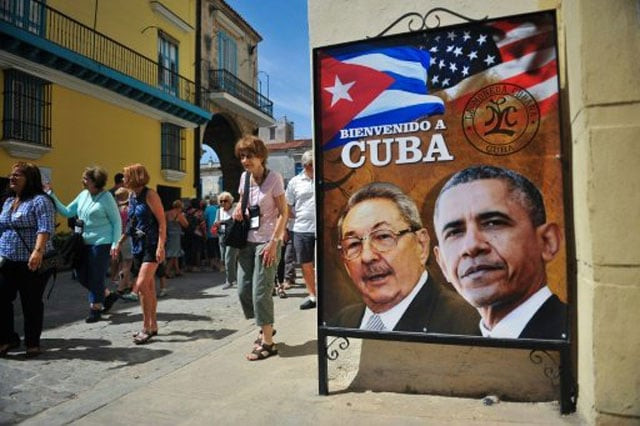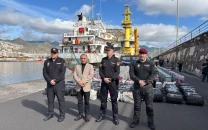Obama's Cuba visit: will they party like it's 1928?
The last time a US president visited Cuba -- way back in 1928 -- he got a rock star's welcome

PHOTO: AFP
Is a repeat impossible when President Barack Obama lands Sunday? Don't bet on it.
Nine decades, one Cold War, and a whole lot of bitterness later after Calvin Coolidge's now forgotten trip to Havana, the atmosphere around Obama's visit feels surprisingly similar.
Obama, like Coolidge, is a lameduck president seeking to leave a big foreign policy mark in his last year in office by ending a standoff between Washington and communist Havana that dates back to Fidel Castro's 1959 ouster of the US-backed government of Fulgencio Batista.
US loosens regulations ahead of Obama's Cuba visit to island
When Coolidge -- or "Silent Cal," as the famously untalkative occupant of the White House is known -- came to Havana, he was also on a peace mission. In his case, it was to dampen regional anger over US policy in Latin America.
Coolidge arrived on the battleship USS Texas, at the head of a convoy including a cruiser and three destroyers. Photos published at the time in the Cuban newspaper Bohemia show Cubans packing the seafront and streets.
"The crowds were tremendous and enthusiastic," wrote Beverly Smith Jr, a New York Herald Tribune reporter, who penned a tell-all version of events 30 years later in the Saturday Evening Post.
As his motorcade wound past cheering crowds "blowing kisses and throwing flowers," the austere Coolidge removed his hat, Smith wrote. The president even found himself bowing to a "bevy of highly painted young ladies" and their "madam" pursuing international relations of a rather different kind.
Unlike Coolidge, Obama will arrive in Havana by air. But the presidential motorcade accompanying Obama's armored limo the "Beast" will still make an arresting, even shocking sight in a city that for decades has prepared for possible war with its giant neighbor.
And the welcome is gearing up to be just as lively. Old Havana is crawling with workers painting and cleaning and polishing, while ordinary Cubans are excited to see history made.
Cuba reports first case of Zika contracted in the country
"It should have happened a long time ago," said builder Sergio Fundora, 52, during a break in the frantic restoration project.
Dipsomaniacs and diplomacy
Smith described the press corps and officials, freed from the miseries of the US alcohol ban known as Prohibition, going on a drinking spree. "Quite a party of us trooped off," he said.
But "Silent Cal" stuck to soft drinks, leading to a near diplomatic crisis when a waiter appeared at a reception with a "big tray of delicate, crystal cocktail glasses, each sparkling to the brim with a daquiri -- rum, fresh lime juice and sugar, well shaken," Smith wrote.
It took "a masterpiece of evasive action" for Coolidge to dodge the waiter.
Today, with the gradual dismantlement of the US economic embargo and rise in tourists to Cuba, Havana is rapidly regaining its reputation as a party city.
In bars like El Floridita, one of the oldest in Havana, the daquiris are flowing and almost everybody on the barstools is foreign.
Bartender William Arias, 52, said it was "entirely possible" that the Coolidge delegation had been there, too. "In those times, Americans who came to drink came to this bar," he said.
Obama's drinking plans sound rather Coolidge-like so far. "Hopefully, I will have time to enjoy a cup of Cuban coffee," Obama wrote to 76-year-old Cuban Ileana Yarza this week in a symbolic renewal of postal services between the two countries.
But history might well repeat itself in the rush to stock up on rum for the journey home.
US law still restricts travelers from Cuba to $100 worth of alcohol or tobacco. That's not enough for a box of cigars - but you can buy a shelf load of $7 bottles of rum.
The problem, points out an advice column this month in The Washington Post, is that airline weight restrictions might force you "to choose between your rum or your clothes."
US-Cuba thaw has yet to reach Guantanamo
It's a dilemma that the 1928 Americans -- informed they could discreetly bring back booze from Cuba to Prohibition America -- would have sympathized with.
Smith wanted to take six half-gallon jars of Bacardi, but they wouldn't fit in his suitcase, leaving the journalist facing the choice described by the Post today. How did he decide?
"I emptied out most of the clothes," Smith wrote.



















COMMENTS
Comments are moderated and generally will be posted if they are on-topic and not abusive.
For more information, please see our Comments FAQ